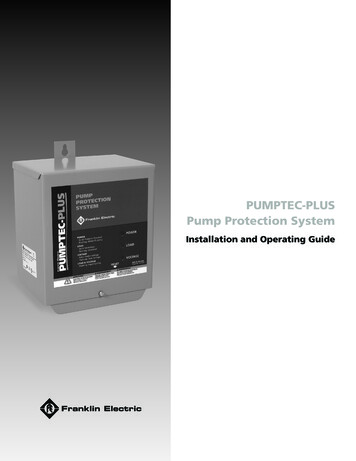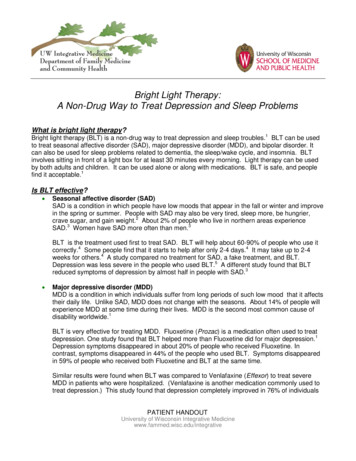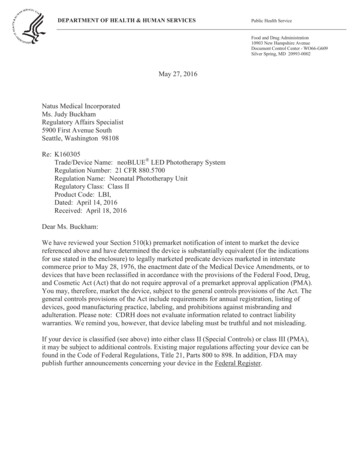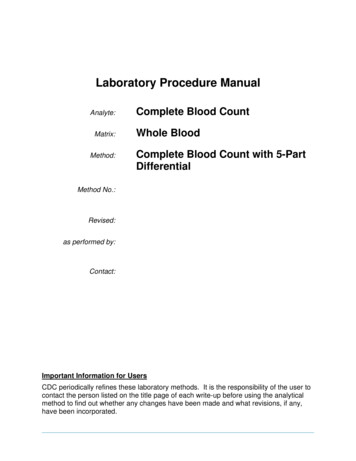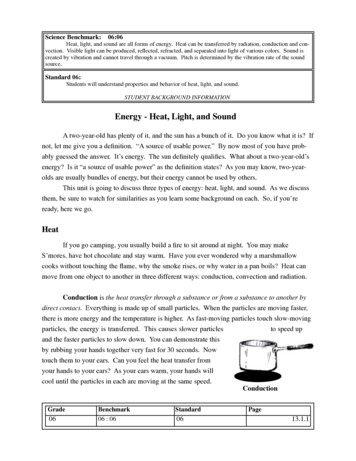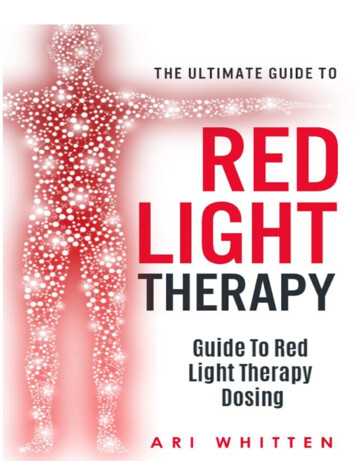
Transcription
The Ultimate Guide toRed and Near-InfraredLight TherapyGuide to Red Light Therapy DosingBy Ari Whitten
Guide to Red Light Therapy DosingBefore we get into a discussion of all the factors that go into device selection and how to get the idealdose of light, let me preface this next section by saying that if you don’t care to understand all thetechnical aspects of this, that is perfectly fine. You don’t need to understand all of the factorsthat go into light selection, power density, joules, the nuances of the mathematical calculationsand so on. If you just want the practical how-to guidance, you can skip to the summary “KeyPoints for Dosing.”I will just add that you do need to pay attention to my warnings not to overdo treatments. While red/NIRlight therapy is very safe, thinking that “more is better” and then overdoing treatments will actuallydecrease the effectiveness. So make sure you understand and adhere to the general guidelines for dosing.Also, please note that dosing in red/NIR light therapy is a tricky and complex issue because of the widevariety of different types of devices (laser units vs. LED panels vs. other devices), a wide range ofdifferent doses used in various studies, the overall body surface area treated, the types of treatment (e.g.general light on an area vs. light on acupuncture points), the goals (e.g. performance enhancement vs. fatloss vs. skin anti-aging), and the specific body tissues you’re trying to affect (e.g. the skin requirement isvery different than that of deep tissue, and something like the brain, which sits behind the skull, mayrequire much larger doses to deliver a significant amount of light).Due to these complexities, different people sometimes have different views on the subject of ideal dosing.For example, I have talked to some people who recommend only very low doses, with lasers. Others whoadvise against lasers. Others who advise much larger doses than what I recommend here, and who thinkthat it’s basically impossible to overdose on red/NIR light therapy. So there are a number of people in thisfield who don’t agree with each other on finer details. With all of that in mind, I am going to do my besthere is to accurately represent the overall body of research and what I perceive to be general consensusof the world’s most respected experts on red/NIR light therapy.The dosing guidelines here are generally intended for use with LED panel-style light devices. (I’massuming most people don’t want to spend 2,500- 30,000 on a laser device, and want to be able to dored/NIR light therapy for less than 1,000 or 500, so I’m focusing on how to do treatments with LEDpanel light devices rather than lasers.)Now, let’s get into a detailed discussion of applying what we’ve learned.If you want an effective light therapy session, you must have an effective dose. That requires: A light that is relatively powerful (i.e. has an ideal “power density”)Ideally, a light that can treat a large area of the body at onceAn understanding of the optimal duration of time using the light to get the right total doseToo little of a dose and you get minimal to no effects. Too strong of a dose and you get minimal to noeffects.Let’s talk about power density of the light first.As mentioned previously, most studies showing benefits of red/NIR light therapy used light outputs of 20200mW/cm2.This is basically a measurement of power density – how much power the light is emitting (in watts) overhow big of an area.To put that in different terms, if you shine the light on your torso (let’s say, for the sake of ease ofcalculation, that it’s an area of 50cm x 40cm, which equals 2,000cm2) And the light you’re using is 200 watts (which is 200,000mW), then you have 200,000mW/2,000cm2 100mW/cm2
That’s a great power density.But, beyond this simple calculation, there are a few nuances here that make this simple calculationconsiderably more complex:1. Distance from the light. It’s also important to be aware that this measure of power densitydecreases dramatically by moving further from the light source. So you’ll get the highestdoses by being within a few inches of the light. Moving further away than about 3 feet from thelight (as a general rule) and you’ll get little to no effect on anything below the surface of theskin. (And that’s using a powerful light. Many lights won’t provide effective doses beyond just12” away.) Essentially, moving closer to the light increases the potency of the light dose, andmoving further away dramatically decreases the dose. However, closer is not universally better –I generally advise staying at least 6 inches away to minimize exposure to EMFs (electromagneticfields), just to err on the side of caution. This applies to all electronic devices, from TVs to dishwashers to blenders. So the sweet spot is generally between 6 - 36 inches, and we’ll talk morelater about when to go closer and when to move further away depending on your goals. Butagain, the point here is to understand that distance from the light dramatically affects the doseyour cells receive.2. Wavelengths of the light. Certain devices emit all the light output/wattage in the effectivetherapeutic wavelengths, and others emit only part of their total wattage in therapeuticwavelengths. Therefore, they may have 20-60% of their total wattage at non-therapeutic or nonoptimal wavelengths. This also factors into the dose. When this is the case, it makes calculationsquite complex.3. Claimed wattage vs. actual wattage. The claimed wattage of a light differs from the actualpower output of the light. This is a critical difference One thing is the claimed wattage that thelight device is rated for, and another thing is the actual intensity of the light emitted. Generally,lights emit a power density about 25-50% lower than the claimed wattage wouldsuggest. So the truth is that even with the calculation above, it’s really just a theory. You don’tknow the true light intensity output of the light you get until you actually measure it. You have torely on actual measurements using a PAR meter, rather than calculated measurements based ontheoretical wattages. Don’t worry – I’ve already done all this for you, so you don’t have to worryabout it. But again, be aware that the actual light output of many devices may be awhopping 50% lower than what the companies are claiming! (If you’re interested inlearning more about this point, Platinum Grow Lights has videos on their websitewhere they compare actual light emission from various lights that are all rated at thesame wattage. They even show in the video how massively the actual light output candiffer from the claimed power.)4. Size of the device/treatment area. One other nuance that’s important to note here is thateven if a device is technically powerful enough to create beneficial effects, it may still be toosmall. In other words, one can have a device that has a power density of let’s say 100mW/cm 2,but it may be a device with only a few inches circumference and thus, only emits light over asmall area of your body. If you’re trying to treat large areas of your body, this makes thingsextremely inefficient and time-consuming.
Overall, the device needs to emit light above a certain power density (light intensity), needs to be at theright wavelengths, be at the proper distance away from your body, and ideally, needs to be physicallylarge enough to emit light over a large portion of your body.But for simplicity, let’s leave all these nuances of the calculations out of it.The next part of the equation is how long should you apply the light. The dose (duration of exposure) iscalculated by:Dose Power Density x TimeSo all we are doing is taking that number we already have (mW/cm2) and then the “dose” can becalculated once you know how long you should apply that light for. (If this sounds complex, don’t worry,because it’s actually VERY simple if you get the lights I recommend). Here’s the equation you need tocalculate the dose:mW/cm2 x time (in seconds) x 0.001 J/cm2Here’s the critical piece of information you need to know: The dose you want to shoot for is between3J/cm2 – 50J/cm2.(Note: Depending on whether you’re treating superficial areas like the skin or surface wounds or deepertissues like muscles/organs, etc., you want different doses. We’ll talk more about the specifics of thosetreatment goals in a later section of this book.)Here are some sample calculations to show you how this works: 25mW/cm² applied for 40 seconds gives 1J/cm² 50mW/cm² applied for 20 seconds gives 1J/cm² 75mW/cm² applied for 15 seconds gives 1J/cm² 100mW/cm² applied for 10 seconds gives 1J/cm²What that means is that if you have a device with a power output of 100mW/cm2 (at the distance you areusing it), then you want your treatment time to be between 30 seconds-7 minutes on a given area of yourbody (that will equate to roughly 3-50J/cm2).If you have a device that has 50mW/cm2 (at the distance you are using it), your treatment time would be1-14 minutes on each area.That’s a pretty wide range of times, so let me simplify this.If you get either of the two top lights I recommend, they emit roughly 90mW/cm² at a distance of 6”away from the light, about 55-65mW/cm² at a distance of about 12 inches away from the light, 3545mW/cm² at 18 inches away, and 25-30mW/cm² at 24” away.If you’re a more visual person, this will help get what I’m saying here:Irradiance at 6" Irradiance at 12" Irradiance at 18" Irradiance at 24"85-95mW/cm255-65mW/cm235-45mW/cm225-30mW/cm2Now you might be wondering, “Okay, so how do I know whether to use it for 1 minute or 10 minutes? Andhow do I know whether to use it from 6” away or 24” away?”Good questions!For skin issues (e.g. anti-aging benefits) and other more superficial (near to the surface) body issues,there are a few things to note. We want a relatively low overall dose on each area of skin, ofroughly 3-15J. Also, there is some indication that lower power densities (below 50mW/cm2) may actuallybe more optimal for treating the skin than very higher power densities. This may cause you to think thatlow power lights are okay, but high power lights still have a huge advantage because they allow you to
move the light further away (note: light spreads out and covers a larger area the further you are awayfrom it) and thus treat a much larger area of your body at once with the optimal light intensity and dose.Smaller lights are much more inefficient and time-consuming, and limited in what they can be used for.(More on this later!)In contrast, for treating deep tissues, you want bigger doses and higher power density (light intensity) foroptimal effects. You want doses of 10-60J. So in general, you’d want to have the light much closer to yourbody with a much higher light intensity. That’s what’s needed to deliver optimal doses of light deep intoyour tissues.To sum up: With skin/surface treatments, you want to be further away from the light (which lowers thelight intensity and covers a broader area of your body) for an overall lower dose. With deeper tissues, youwant to be closer to the light (which increases the light intensity) for an overall higher dose.To make this very specific and practical, here are some simple guidelines: - FOR SKIN ISSUES: Assuming you have one of the lights I recommend, for skin issues (e.g. antiaging benefits) and other more superficial (near to the surface) body issues, here are my basicusage suggestions:Somewhere between 1-4 minutes from 12” away. (Note: For skin issues, I recommend going 12”or more away from the device, whereas with deeper tissues, you want to be closer and have higherpower density to reach deeper into the tissues.)Or 1.5-5 minutes from 18” away.Or 2-8 minutes from 24” away.FOR DEEP TISSUES: For deeper issues in muscles, tendons, ligaments, bones, glands, the brain,organs, etc., you want much higher doses more in the neighborhood of 10-60J. In general, thismeans that you want higher power devices and you want to be 6-12” from the device (as opposedto further away as with treating the skin) to get optimal doses of light to those deep tissues. Thedeeper the tissue you’re trying to treat, the closer to your body you want the light to be (i.e. 6” isideal) and the higher the overall dose you want to do, so that you deliver adequate therapeuticdoses to the deeper tissues. Also, for use on the brain, this may require higher doses (or doses onthe higher end of the spectrum shared here) because it takes a relatively higher dose for enoughlight to penetrate through the skull and be delivered to the brain. Here are my general suggestionsfor treating deep tissues below the skin:- Using the light from 6” away for between 2-7 minutes per area is the ideal dose range.- Or 5-10 minutes per area from 12” away. (For treating deep tissues, I don’t recommend goingfurther away than 12” away from your body.)If you get the lights I recommend, that’s really all you need to know.If you choose a different device than one I recommend, you’ll have to do the calculations yourself usingthe above equations. And now that you know how to do all this math, you can certainly do thesecalculations for yourself. The only tricky part is that actual wattage is often much lower than claimedwattage for many lights, so if your calculations are based on the claimed wattage instead of actualmeasurements using a PAR meter, your calculations will likely be off by a fairly wide margin.Reminder: More is not necessarily better! As you’ll see below, there is something called a“biphasic dose response” whereby doing too much can actually result in a lesser benefit rather thanmore. So don’t assume that “if a little is good, a lot must be better.” All you’re doing isdecreasing the benefit by doing more than the recommended doses. Let me repeat that foremphasis: Doing larger doses than what I recommend will render less of an effect, not more.For those of you with health struggles, if you are very ill or your health is s
light therapy is very safe, thinking that “more is better” and then overdoing treatments will actually decrease the effectiveness. So make sure you understand and adhere to the general guidelines for dosing. Also, please note that dosing in red/NIR light therapy is a tricky and complex issue because of the wide variety of different types of devices (laser units vs. LED panels vs. other .
